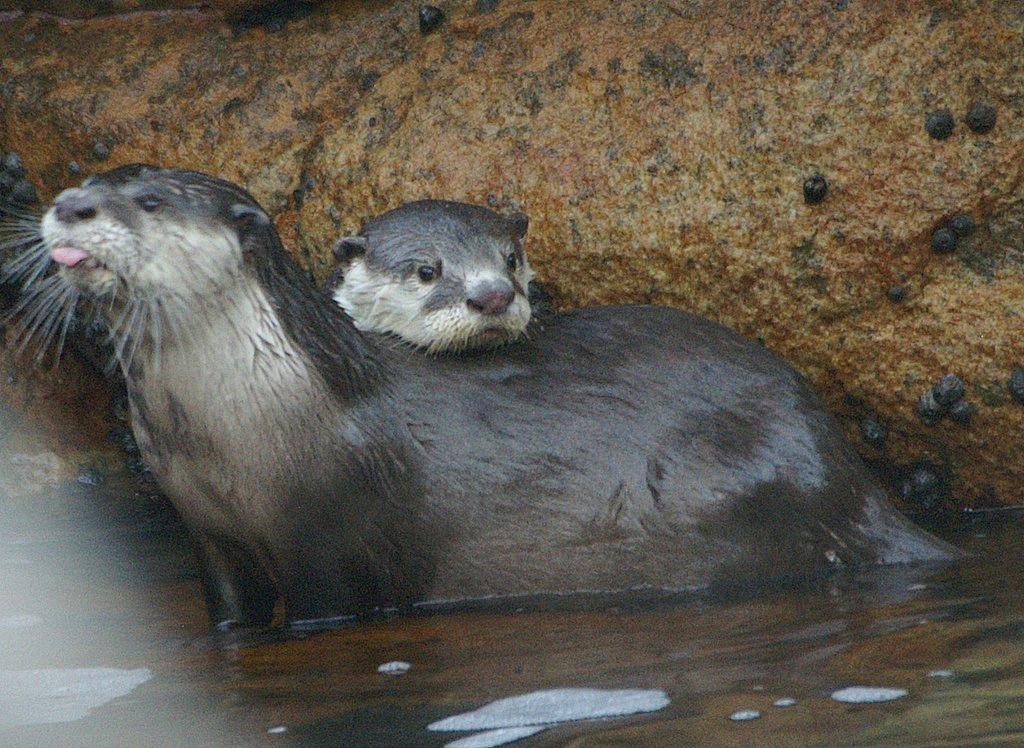The African clawless otter, scientifically known as Aonyx capensis, is a fascinating species that is well adapted for its unique habitat and prey. With its large molars, this otter is able to crush and consume crabs and lobsters, which make up a significant part of its diet. However, it is also known to prey on frogs, fish, and insects.
One of the distinctive features of the African clawless otter is its lack of claws. Instead, it possesses paws with reduced webbing, which provides the otter with incredible dexterity. This adaptation allows it to navigate various environments with ease, including both land and water.
The distribution of the African clawless otter, also known as the Congo clawless otter, is quite patchy. It can be found in the Congo River basin, which includes countries such as the Democratic Republic of Congo, Republic of Congo, Central African Republic, Gabon, Cameroon, and Equatorial Guinea. Additionally, it can be found in Burundi, southwest Uganda, and Rwanda.
In terms of physical characteristics, Cape clawless otters, which are a subspecies of the African clawless otter, can grow up to a maximum length of 2 meters when including their tail. They can weigh up to 18 kilograms. These otters have light to dark brown fur on their backs, while their face, throat, belly, and ears are white. Their ears, although small, are rounded in shape.
The African clawless otter is an important member of its ecosystem, playing a role in maintaining the balance of various populations. Its diet and hunting habits contribute to the control of crustacean and insect populations, while its presence in rivers and wetlands helps to maintain healthy aquatic ecosystems.
Despite its adaptability, the African clawless otter faces various threats to its survival. Habitat loss and degradation due to human activities, such as deforestation and pollution, pose significant challenges to the otter’s population. Additionally, illegal hunting and trapping for fur and bushmeat trade further threaten its existence.
Conservation efforts are crucial to ensure the survival of the African clawless otter. Protecting its habitat, implementing sustainable fishing practices, and raising awareness about the importance of this species are essential steps in its conservation.
The African clawless otter is a remarkable creature with unique adaptations that allow it to thrive in its environment. Its large molars, lack of claws, and reduced webbing on its paws make it a skilled predator, capable of consuming a variety of prey. While its distribution may be patchy, efforts must be made to conserve this species and protect its habitat. By doing so, we can help ensure the continued existence of this fascinating otter species.
Do African Clawless Otters Have Claws?
African clawless otters do not have claws. Unlike other otter species, they have adapted to their environment and do not possess claws on their paws. Instead, they have reduced webbing on their paws, which gives them incredible dexterity. This lack of claws allows them to maneuver and manipulate objects more easily.
The African clawless otter’s diet primarily consists of crabs and lobsters, which they are able to crush with their large molars. However, they also prey on frogs, fish, and insects. Their specialized teeth are well-suited for crushing the hard exoskeletons of their prey.
The African clawless otter’s name is somewhat misleading, as they do not have claws. Their adaptation without claws, along with reduced webbing on their paws, gives them remarkable dexterity and allows them to thrive in their environment.
Where Does The Congo Clawless Otter Live?
The Congo clawless otter, also known as the African clawless otter (Aonyx capensis), is primarily found in the Congo River basin. This region encompasses several countries including the Democratic Republic of Congo, Republic of Congo, Central African Republic, Gabon, Cameroon, and Equatorial Guinea. Additionally, these otters can be found in Burundi, southwest Uganda, and Rwanda.
To summarize, the distribution of the Congo clawless otter is quite patchy, but they are primarily found in the Congo River basin, along with other countries such as Burundi, southwest Uganda, and Rwanda.
How Big Is A Cape Clawless Otter?
A cape clawless otter can reach a maximum length of 2 meters, including its tail. In terms of weight, they can weigh up to 18 kilograms. These otters have a distinct appearance with light to dark brown fur on their backs, while their face, throat, belly, and ears are white. Speaking of ears, they are small and rounded in shape. To summarize the size of a cape clawless otter:
– Maximum length: 2 meters (including the tail)
– Maximum weight: 18 kilograms
These otters have a unique color pattern and small, rounded ears, making them easily identifiable.
Conclusion
The African clawless otter is a fascinating species that is well-adapted to its environment. With its large molars, it can easily crush its primary prey of crabs and lobsters, but it is also versatile enough to consume frogs, fish, and insects. Its lack of claws and reduced paw webbing give it remarkable dexterity, allowing it to navigate its surroundings with ease.
The distribution of the African clawless otter is patchy, with populations found in the Congo River basin, including the Democratic Republic of Congo, Republic of Congo, Central African Republic, Gabon, Cameroon, and Equatorial Guinea. They can also be found in Burundi, southwest Uganda, and Rwanda.
Cape clawless otters, a subspecies of the African clawless otter, can grow up to 2 meters in length (including the tail) and weigh up to 18kg. They possess a distinctive appearance, with light to dark brown fur on their backs and a white face, throat, belly, and ears. Their small and rounded ears add to their unique features.
The African clawless otter is a remarkable creature with its specialized dentition and physical adaptations. Its distribution may be limited, but it thrives in its chosen habitats. Understanding and appreciating the unique characteristics of this species is crucial for its conservation and ensuring its continued existence in the wild.

